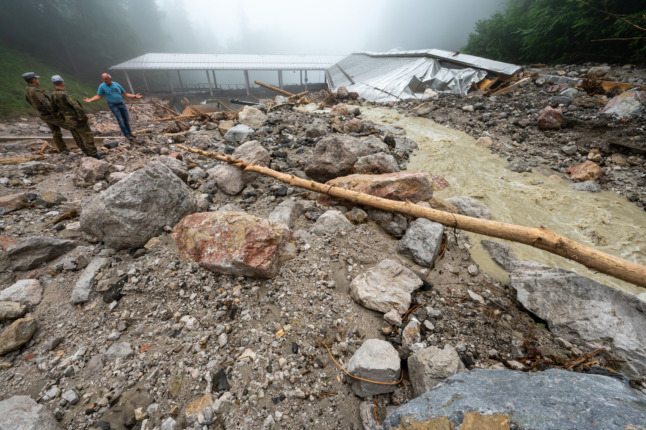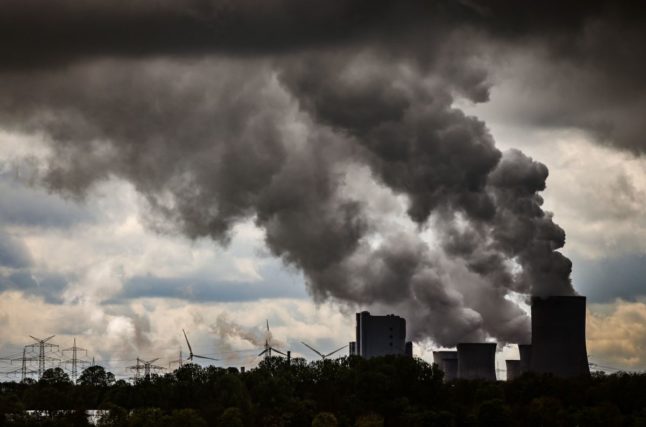The situation has stabilised in the state somewhat as experts forecast sunny weather, but the district of Berchtesgaden near the Austrian border is still dealing with the devastating consequences of the rainstorms.
The small town of Schönau am Königssee was especially badly hit by floods overnight on Sunday. Its beloved toboggan and bobsleigh track was ripped from its foundations by gushing ravines up in the mountains.
“We could never have anticipated this,” Thomas Schwab, General Director of the German Bobsleigh and Toboggan Association told regional radio station BR24.
The iconic track, which has been around for five decades, was known worldwide as a training ground for winter-sport world champions and Olympic athletes.
READ ALSO: Two dead as flooding hits German states of Saxony and Bavaria
Writing on Twitter, winter sports journalist Ken Childs said the track had hosted “some of the best racing the world has seen”.
When I ask athletes what their favorite track is, Königssee comes up a lot. It’s the first artificially cooled sliding track and it’s put on some of the best racing the world has seen.
These photos are courtesy of Michael Berger, the track is destroyed due to the flooding. pic.twitter.com/GybqXnmfri
— Ken Childs (@TheKenChilds) July 18, 2021
Olympic toboggan champion Felix Loch told BR24 that he feared the track could not be rebuilt – or that it would take years to do so.
“The track has been there for a long time and there were always conflicts around it,” he said. “It costs a lot of money and it was always facing headwinds and opposition from various interests.”
READ ALSO: IN PICTURES: The aftermath of Germany’s catastrophic floods
On Monday, the Technical Relief Organisation (THW) and the army were brought on site with heavy equipment to clear rubble and debris from kilometre-long road that led to the buried start house.
Markus Aschauer, operations manager of the Königssee Ice Arena, was pictured talking to soldiers next to the wreckage, while Bavarian state premier Markus Söder (CDU) and Finance Minister Olaf Scholz (SPD) also visited the site to assess the damage.

Markus Aschauer, operations manager at the Ice Area in Königsee, speaks to soldiers in front of the ruined remains of the toboggan run. Photo: picture alliance/dpa | Peter Kneffel
Söder meets traumatised flood victim
On his visit to Schönau am Königssee, Söder and Scholz were approached by a distraught resident who had lost everything in the floods.
Visibly in shock, the woman had to be supported by two other people as she wept and asked the two politicians for help.
“We can help with that, we really can help,” Söder told her. “Nobody will be left on their own.”
Bayern hilft: Lagebesprechung Hochwassergebiet Berchtesgadener Land. Innerhalb von Sekunden haben Menschen alles verloren – erst im Westen und jetzt bei uns. In dieser existenziellen Not braucht es schnelle Hilfe. Großer Dank allen Rettungskräften. Sie leisten Übermenschliches. pic.twitter.com/pgQWCMRKjA
— Markus Söder (@Markus_Soeder) July 18, 2021
As the rain fell over the weekend, residents of the small Bavarian town were forced to leave their homes overnight as an emergency measure.
Most have now been able to return, though three properties are now uninhabitable due to the scale of the damage.
Since catastrophic floods first struck western Germany on Wednesday, several funds have been set up to support those affected. Politicians are also said to be considering a €400 million emergency aid packet to assist those who have lost their homes and belongings nationwide.
READ ALSO:
- ‘Solidarity in crisis’: Financial aid pours in for German flood victims
- EXPLAINED: How you can support victims of the German flood tragedy
Brighter weather forecast eases floods fears
After the horror of the weekend, weather experts have forecast dry, sunny weather over the coming days – meaning many residents of Bavaria can breathe a sigh of relief.
In the city of Passau, the water levels along the Danube rose to 8.18 metres on Monday, just 32cm short of breaching the highest water level (‘Stage 4’) of over 8.5 metres.
But with the sun breaking through the rainclouds, experts and residents are now hopeful that it won’t reach that critical mark.
Im Süden ist es sommerlich warm mit teils über 25 Grad. Kälter ist es unter den Wolken rund ums Erzgebirge mit teils nur 11 bis 13 Grad. Zum Ablesen in die Länder/Kreise. https://t.co/g8ymsrGraH
& hier das Messnetz der Vereinigten Hagel:https://t.co/IzdrC9ySVu
/CG
— Kachelmannwetter (@Kachelmannwettr) July 19, 2021
However, the parts of Bavaria worst-hit by the floods – Berchtesgaden, Schönau am Königssee, Ramsau, Bischofswiesen und Markt Schellenberg – are still attempting to repair the terrifying destruction to homes and businesses, and mourning the loss of two lives.
Environmental experts are also surveying the landscape around Schönau to assess the risk of landslides.
Meanwhile, the authorities in Munich have banned residents from swimming or boating in the Isar river until the high water levels subside. Taking to the water would mean risking “life and limb”, they said in a statement.




 Please whitelist us to continue reading.
Please whitelist us to continue reading.
Member comments